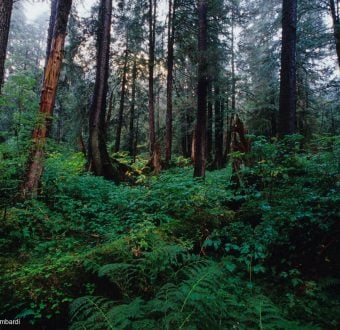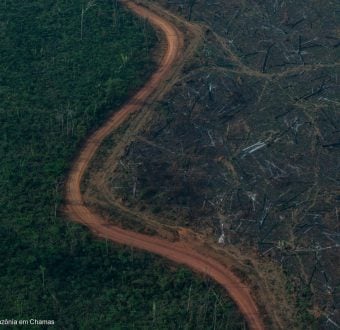In a joint statement, the four appellants described Prince of Wales as a national treasure because of its unique ecological values. They also explained that high levels of past timber extraction and road construction had heavily compromised these values, and that the proposed project poses unjustifiable risks to the area’s fish and wildlife populations, to subsistence uses, and to the primary drivers of the regional economy – tourism and fishing.
Larry Edwards of Greenpeace explained that “the Logjam Final EIS failed to follow the simple requirement of NEPA (the National Environmental Policy Act) to candidly disclose the impacts of the agency’s intended action. A truthful ‘hard look’ at impacts is necessary, including a full and fair discussion of all responsibly raised issues. The Logjam FEIS failed to meet this standard regarding a number of important wildlife, fisheries and subsistence issues. The decision should have been revoked.”
Edwards cited the project’s 28 miles of new roads in an area where road density already exceeds Forest Plan guidelines as one of the key issues. “Wolf experts consider such a high road density to be a key factor toward unsustainable wolf mortality,” said Edwards. “Problems began in the draft EIS when the Forest Service made the patently false statement that the state had not raised a wolf mortality concern involving the project. Then, the FEIS and decision document avoided any disclosure or discussion of a subsequent letter on the matter from the Alaska Department of Fish & Game. That letter raised significant environmental concerns, and the unethical cover-up violated NEPA.”
Gabriel Scott of Cascadia Wildlands agreed with the concerns about increasing road densities in the project area. “The Forest Service has a twenty million dollar maintenance backlog on Prince of Wales Island, and yet it insists in the FEIS that project impacts to fish populations will be temporary on the basis of future mitigation.” Scott said that his organization focused on this backlog in its appeal, particularly the numerous existing failed fish passage structures that block salmon from accessing spawning habitat.
Commercial fisherman Dave Beebe of nearby Petersburg agreed with Scott’s concerns. “We depend on healthy fish populations,” said Beebe. “But this project, combined with the Forest Service’s large and growing backlog of avoided road maintenance and fish-blocked culverts in the area, is a significant detriment to our fisheries. Nearby watersheds on Prince of Wales Island are known for their repeated spawning failures, as a result of logging impacts. It is time to stop degrading the watersheds on the island and taking risks, but in planning this project the Forest Service glossed over the problems it had already created there.”
Mark Rorick of the Sierra Club cited the enormous public cost associated with the timber sale program as another significant problem with the project. “This sale is just another example of a bad allocation of taxpayer’s money that is being used to support a non-competitive industry that does harm to our environment.” Former Forest Service economist Joe Mehrkens has tracked Tongass subsidies since 1977 and echoed Rorick’s concern about the costs associated with the project, particularly the road subsidy and sale administration costs. “The Logjam timber subsidy is a loss of 94 cents on every taxpayer dollar spent,” said Mehrkens.
Carol Cairnes, president of the Tongass Conservation Society, said that her organization’ s members are dedicated to protecting biodiversity across the Tongass and returning plant and animal habitats as close to their natural condition as possible through sound management. “We appealed the Logjam decision because the habitat has been severely damaged and is not recovered. The Forest Service is trying to conceal facts,” she said. “Former Forest Service Chief Jack Ward Thomas admonished the agency when he headed it to ‘tell the truth – all the time’ and the Forest Service has not done that in the Logjam FEIS.
Cairnes also said that the Tongass plays an important role in global climate change mitigation. “The trees of the Tongass actively remove carbon dioxide from the atmosphere and store huge amounts of it in the soil and vegetation. Projects like Logjam negate that key role, and that is a significant impact. We’re taking a stand on the Logjam project because the best available science needs to be the bottom line for Tongass management concerning climate and fisheries habitat.”
All of the appellants expressed disappointment that Regional Forester Bschor affirmed the decision rather than remanding it to Forest Supervisor Cole in order to correct the legal deficiencies. Cairnes said the four groups were evaluating their options at this point now that the appeal decision by the Forest Service has been finalized.
VVPR info: Greenpeace: Larry Edwards (907) 738 – 1878 (through September 27); (907) 747-7557 (after September 27) Cascadia Wildlands: Gabe Scott (907) 491-0856 Juneau Group of the Sierra Club: Mark Rorick (907) 789-5472 Tongass Conservation Society: Carol Cairnes (907) 617-8908 Dave Beebe Cell: (907) 340-6888; Home: (907) 772-2270 Joe Mehrkens (907) 789-3323

